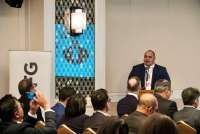JAKARTA. When Beatrice Anindita, 27, studied in Singapore a few years ago, she furnished her apartment almost entirely with the affordable, versatile products offered by Ikea.
“If I have an apartment here in Jakarta, I would be enthusiastic to have my whole apartment be ‘designed by Ikea’,” Beatrice said, who now lives with her family in a more spacious home. “But even for bigger homes, items that function to coordinate different pieces of furniture are needed to make the space more efficient — and I can find them, with style, in Ikea.”
With the housing market squeezed by skyrocketing land and rent prices, the 28 million residents of Greater Jakarta are in dire need of home furnishing products that can maximize limited space.
This, and the rise of the middle class in Southeast Asia’s largest economy, will likely benefit Ikea, the Swedish furniture store known for its stylish yet affordable products.
Starting Wednesday, Ikea — which is famous for the Swedish meatballs on offer at its cafeteria — will open its first Indonesian outlet on a 35,000 square-meter property in Alam Sutera, Tangerang, some 25 kilometers away from Jakarta’s city center.
“Indonesia has been a booming economy for the last ten years. We judge now is the time when there are enough customers coming into the middle-class bracket who can afford to shop at Ikea,” Ikea Indonesia general manager Mark Magee told reporters during a store preview event that took place on Monday.
Over the past decade, Indonesia’s economy has grown between 4 to 6 percent per year, helping to elevate nearly a third of its more than 250 million citizens — or some 74 million persons — into the middle-class or affluent consumer status.
This figure is projected to double by 2020, meaning that each year, between 8 and 9 million persons will enter the middle-income bracket each year, according to a study by the Boston Consulting Group.
In 2006, just 25 percent of Indonesian households had television, a refrigerator and a car or motorcycle. By 2012, that number catapulted to 42 percent, indicating stronger purchasing power, wrote Debnath Guharoy of Roy Morgan.
Ikea, which targets middle- to upper-class customers by offering fashionable products at relatively affordable prices, expects to tap a third of the 28 million Greater Jakarta residents and reach two-thirds within the next ten years, according to Magee.
The Ikea Alam Sutera store will provide 7,000 home furnishing products, of which 550 will be manufactured in Indonesia and distributed across the globe.
“We [already] have 23 years of manufacturing here in Indonesia, with products ranging from soft toys, rattan furniture, textiles, ceramic, water hyacinth, rugs, to pine furniture,” said Pikki Aziz, Ikea Indonesia store sales manager.
Ikea Indonesia head of marketing Benedicte Hansen said that products made in Indonesia could be sold at lower prices than in Ikea stores elsewhere because of reduced distribution costs.
Ikea is able to sell its products at affordable prices because it merges high-volume sales with low-level distribution costs due to “flat-pack packaging” that accommodates shipments of more items than other furnishing retailers utilizing larger packaging techniques do, Hansen said.
This necessitates a “do it yourself spirit” among customers, however, as the flat packs mean furniture must be independently assembled, she added.
The arrival of Ikea will undoubtedly alter the landscape of the home furnishing retail industry, with competitors like publicly listed Ace Hardware and its sister company, Informa, scrambling to maintain market shares. Currently, Ace has more than 100 outlets and Informa has over 50 stores throughout
Indonesia.
“When Ikea opens, it needs to be big. That’s why Ikea stores around the world are generally located on the outskirts of the city center. But because of its quality products and cheap prices, consumers keep coming. So traveling should not be that big of an issue,” said Harry Su, head of equities and research at Bahana Securities.
“The key to success for a retailer is to have a good network, both to producers or suppliers and to consumers,” said Woori Korindo Securities Indonesia analyst Reza Priyambada. “Ikea needs to be expansive,” he added.
Ikea Indonesia will open a second outlet once market conditions support it, company executives say. Meanwhile, Ace Hardware will proceed with its “aggressive expansion”, opening 15 stores each year, according to head of investor relations and corporate secretary Helen Tanzil.
“This [expansion plan] will not be affected by the change in the competitive landscape,” Helen wrote in an e-mail interview. “Of course our hope is that we can maintain our market share as realized by a consistent and healthy growth of sales.”
Ace Hardware’s expansion strategy has generated Rp 2.2 trillion in revenues in the first half of this year, up 22 percent from the previous year. Net profit, meanwhile, has risen 32.58 percent to Rp 245.61 billion.
Harry from Bahana said that some 20 to 30 percent of Ikea and Ace Hardware’s items were similar, so a downward performance on Ace Hardware should be expected.
“The impact could be on a weaker top line and margin, as [Ace Hardware] cannot be as lenient as before in raising selling prices due to the new competition. This will in the end affect [Ace Hardware’s] bottom line,” he explained.
While competitors will undoubtedly take revenue hits, publicly listed retail chain operator Hero Supermarket will benefit, as the company holds the license for Ikea to operate in the country, and Ikea’s income will be consolidated in its financial performance book.
“There will be some positive impacts, but Hero is still suffering. If we look at Hero’s financial results, its margin continues to drop. It can no longer grow,” Harry said.
Hero corporate secretary Vivien Goh declined to comment, saying the company would disclose details about Ikea’s potentials and investment after its third-quarter earnings announcement.
Publicly-listed Hero’s comprehensive income sank to only Rp 15.67 billion during the first semester of this year from Rp 174.81 billion in the January-June period of last year, although revenue rose 17 percent to Rp 6.5 trillion. Other than the Hero supermarket, the company also owns Giant hypermarket, Starmart minimarket, Guardian health and beauty shop, among other businesses. (Esther Samboh)
/2012/10/01/612898366p.jpg)









